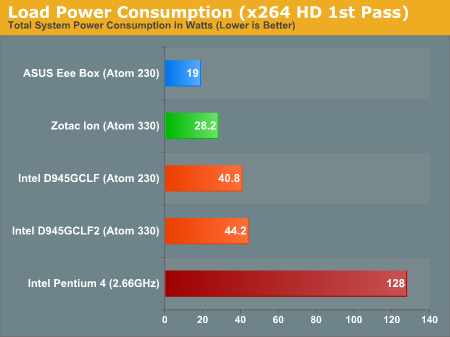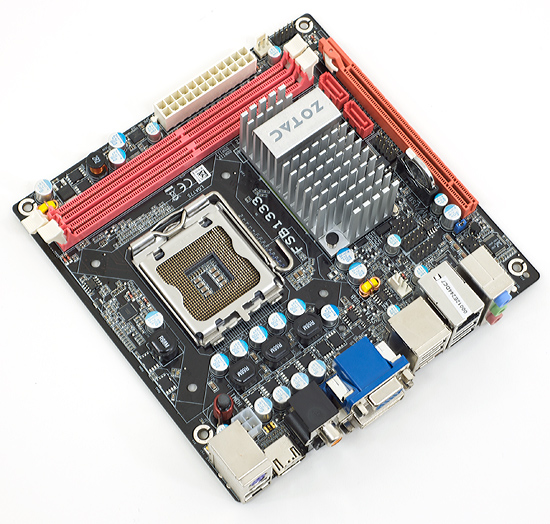Zotac's Ion: The World's First mini-ITX Ion Board
by Anand Lal Shimpi on May 12, 2009 12:00 AM EST- Posted in
- GPUs
Power Consumption
Compared to the Intel Atom boards, the Zotac wins out - it doesn't have to use a bulky desktop power supply which isn't as efficient at these low power draws. Compared to something more similar however, like the Atom 230 based ASUS Eee Box with its own external DC power supply, we see that the Zotac Ion does draw more power than Intel's Atom platform. I'm not sure how much more this could be cut down when used in a netbook/notebook, but that could be a deal breaker for more mobile versions of Ion.


Final Words
What do I think of the world's first mini-ITX Atom Ion motherboard? I like it. Zotac did a good job of delivering pretty much everything I'd want in a board like this, going even further than expected and offering a solution with an external power brick. I don't like the external power option from a long-term replacement standpoint, but I do appreciate its convenience. My only complaint is the price, at $189 it's a bit expensive for the performance you get but I do concede that there are some benefits in the convenience department. All you need to add is memory and some sort of storage and you're good to go, you'll have a system that's easily capable of playing back high definition content (not to mention very power efficient while doing it).
The general application performance of the Zotac Ion isn’t actually any better than the Intel D945GCLF2. It’s when you look at GPU-enabled applications that the Ion holds any real performance benefit. Blu-ray playback or 3D gaming are its real performance strengths; if you plan on doing neither then the platform isn’t very useful.
I did try some CUDA applications on the Zotac Ion board and they were definitely faster than using the CPU alone. While our x264 test managed around 12 fps on the Zotac Ion, using Badaboom I was able to encode at just under 20 fps.
When it comes to the Atom processor, at least on the desktop, there’s simply no reason to opt for the single-core model. Most tasks are so completely CPU bound on Atom that any increase in processing power is instantly noticeable. The Atom 330 ends up being faster than even a 1.6GHz single-core Celeron 420 in many tests, particularly video encoding and 3D rendering, while falling behind in other applications like WinRAR and even our general SYSMark tests. With enough cores, the Atom architecture is efficient in delivering good floating point performance it seems. Branchy integer code however favors the speculative execution engines of more conventional desktop microprocessors. The only reason I see the single-core Atom being of any use is if you're building a cheap file server, but otherwise the Atom 330 is so much faster across the board that it's more than worth it. Hyper-Threading definitely helps the Atom 230, but there's no replacement for another fully functional core. The added power consumption is nothing serious.
If you do need more CPU power, Zotac actually offers an LGA-775 version of the board but it of course requires a standard power supply:

Power consumption on the Zotac Ion is appreciably low, thanks in part to its 90W DC power supply. Compared to ASUS’ Eee Box however, the Ion system does use nearly 50% more power under load.
Everyone seemed to want an Ion based motherboard after NVIDIA first showed off its reference platform. Acer delivered the first Ion system, but it looks like Zotac is delivering what we all wanted from the start. Now it's time to see how people start using these things....










93 Comments
View All Comments
Pirks - Tuesday, May 12, 2009 - link
Jeebus, you'd prefer PCI-e x16 and Wi-Fi with uberslow CPU like Atom? If you check newegg you'll find a bunch of AM2 mini-ATX mobos better that this slow Intel p.o.s.Say this one http://www.newegg.com/Product/Product.aspx?Item=N8...">http://www.newegg.com/Product/Product.aspx?Item=N8... has Wi-Fi and desktop DDR you love so much.
Ah, whatever, if you love uberslow CPUs so be it. I'll never get it why people buy Atom p.o.s. for desktops when there are so many excellent and cheap AM2 solutions around.
strikeback03 - Wednesday, May 13, 2009 - link
Notice he said LGA board, look at the last image on the last page. Not referring to the Atom board that was the subject of most of the article.kalrith - Tuesday, May 12, 2009 - link
I'm curious as to why this is in the video-card section and not in the motherboard sectionZingam - Tuesday, May 12, 2009 - link
PMU Versoin - don't these guys ever read what they type? And if that's a final version - I don't want to touch it. If there are mistakes like that I don't want to image what other bugs could they have implanted into it.DigitalFreak - Tuesday, May 12, 2009 - link
They must have the DailyTech guys proofread for them.AmdInside - Tuesday, May 12, 2009 - link
Just curious how well the motherboard w/ dual core ATOM would do with MAME? I am tempted to build a new HTPC on this but it must also play my MAME games smoothly.vajm1234 - Tuesday, May 12, 2009 - link
in b/w the winrar and WOW charts ""Once more, the Pentium 4 gets beat by the Atom 330 but loses to the Atom 230."" :PKidneyBean - Tuesday, May 12, 2009 - link
I hear that sometimes when you make a computer without any moving parts (using a flash drive) that sometimes a component will emit electrical buzzing noises. Did you hear anything like that?I may use this as a desktop computer.
KidneyBean - Tuesday, May 12, 2009 - link
Never mind, I wouldn't use this as a desktop computer. For me, any power savings would be cancelled by the slow performance.KidneyBean - Tuesday, May 12, 2009 - link
I like how you provided a comparison to the Pentium 4. I'm often upgrading people from older computers to newer ones and it's nice to be able to tell them how much faster the newer ones are. People who still have a high speed Pentium 4, and don't do gaming, are about at the point of needing to upgrade. Good job!